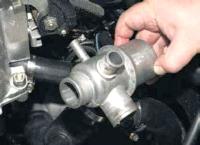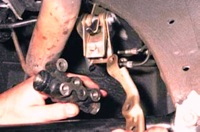Engine knocks
If you think that the engine sounds that were not there before, immediately check if everything is in order with the engine
Most often, engine knocks are associated with serious malfunctions, for diagnosing and eliminating which you will have to disassemble the engine in a service or garage.
You can try to determine the cause of the knocks on your own in order to decide whether to go to the car service on your own or in tow.
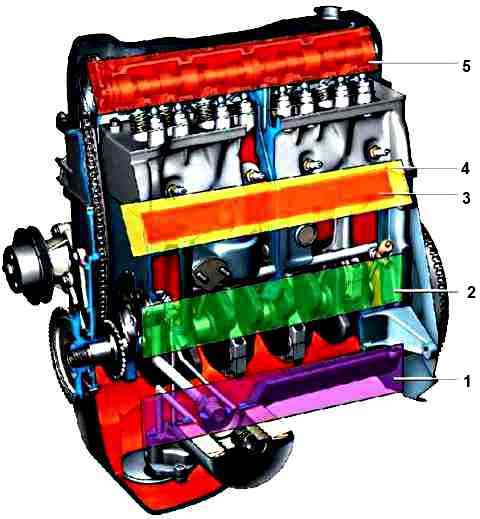
If you have the slightest doubt about self-diagnosis, take out the towline. Serious repairs to a damaged engine will cost more than a towing service.
The knock of the main bearings is very dangerous; stop the engine immediately, you will have to go to the car service or garage in tow.
A low-pitched knock. It is audible in the lower part of the crankcase, noticeably increases under load and with an increase in speed.
Often its appearance is accompanied by a drop in oil pressure (the oil pressure drop lamp is on almost constantly).
The knock of connecting rod bearings is very dangerous; stop the engine immediately, go to a car service or a garage in tow.
The sound is rhythmic, sonorous, metallic, of medium tone.
Significantly increases with increasing load and disappears completely when the spark plug is turned off.
The sound of piston pins is dangerous; without loading the engine, you can drive to a car service or garage on your own.
Rhythmic, high tone with a sharp metallic tint, audible in all engine operating modes and intensifies with increasing engine load.
Completely disappears when the spark plug is disconnected.
The sound of worn pistons and cylinders is harmless; without heavily loading the engine, you can drive to a car service or garage on your own.
A sound like rattling pottery.
Especially audible on a cold engine, decreases or disappears as it warms up.
Valve knock is not dangerous, you can drive to a car service or garage on your own.
Metal clatter against the background of a general muffled noise.
It is well heard at low and medium speeds of the crankshaft from the side of the cylinder head above the valve locations.
Valve knocking usually appears when hydraulic lifters fail, which in this case must be replaced.
Knock knocks are dangerous, but usually eliminated by replacing the knock sensor.
Without loading the engine heavily, you can drive to a car service or garage on your own. Voiced metallic knocks that occur, as a rule, when the car accelerates.
Reason - failure of the knock sensor, the use of low-octane fuel, engine overload with too early upshift, significant carbon formation in the combustion chambers.
It is necessary to replace the knock sensor and apply a special fuel additive to remove carbon deposits on the valves and in the combustion chambers.
Knocks in the suspension and transmission
If extraneous knocks appear in the suspension of a moving car, it is necessary to immediately establish their source, regardless of whether it is a constant knock or appears only when driving through bumps.
Failures in the suspension and steering of the car can lead to a serious accident!
It is better to check the condition of the suspension by putting the car on a flyover, inspection ditch or lift, and if this is not possible, you can do this work on a free flat area, albeit with less convenience. In any case, you will need an assistant.
Begin the check by carefully inspecting the condition of the suspension parts.
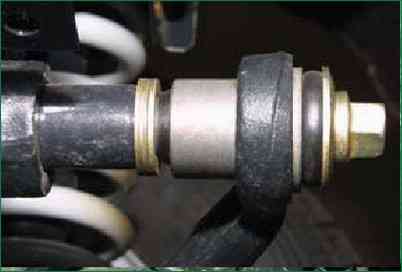

Check the condition of the rubber-metal hinges of the lower and upper arms of the front suspension, the rubber bushings of the stabilizer bar and the reliability of fastening of their brackets.
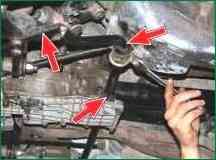
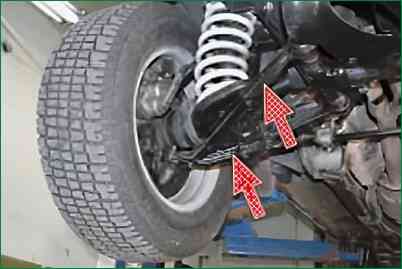
Take a close look at the suspension arms.
Cracks and mechanical damage to the levers, especially at the attachment points of ball joints, are unacceptable.

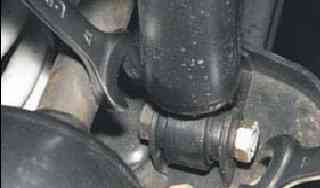
Check the security and condition of the upper cushion and the lower mounting of the front and rear shock absorbers.

Replace pads and bushings with torn, cracked, or bulged rubber on one side
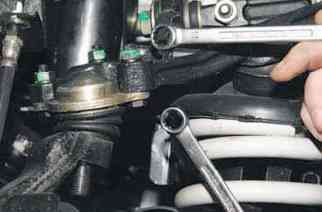
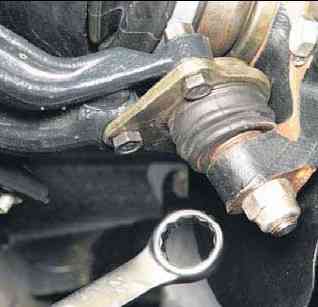
Check for wear on ball joints and front suspension mounts
To check the hinges, raise the front wheel with a jack (or hang the car on a lift, placing a support under the lower arm and lowering the car a little to relieve the hinges).

Swing the wheel in a vertical plane, and the assistant should press the brake pedal to eliminate possible play in the hub bearings.
If play is felt (the upper outer edge of the caliper moves more than 0.5 mm; this distance can be measured, for example, using an indicator), then the hinges are worn out, they can make a knock when driving over bumps and must be replaced.
Swing the wheel in a vertical plane, with one hand on the top and the other on the bottom of the wheel with the brake pedal released.
Increased knocking from the side of the central part of the wheel indicates a large gap in the hub bearing.

When checking the rear suspension, pay attention to the condition of the hub bearings, shock absorbers, springs, longitudinal and transverse rods and shock absorber rod attachments to the body.
Carefully inspect the rear axle cross bar bracket on the body.
After replacing individual parts of the front suspension, it is imperative to check and adjust the angles of the front wheels.
This operation should be carried out on a special stand in a car service, since improper wheel alignment leads to increased tire wear, increased fuel consumption and deterioration of vehicle stability and controllability.
Pay attention to the exhaust system.
Very often, due to the use of non-standard elements or a break in the elements of the silencer suspension, it can be a source of strong knocking, especially during regassing.
To check, stop the engine, carefully inspect the exhaust system, check the reliability of the mounting and suspension of the muffler.
Holding the end of the exhaust pipe, shake the muffler up and down and from side to side - there should be no knocks.
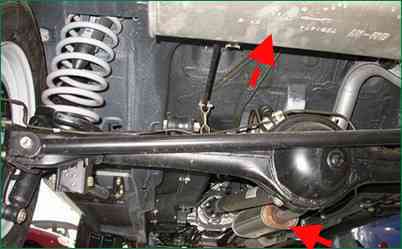
Knock (noise) in the driveline
It is quite difficult to diagnose the serviceability of a driveline by the noise it makes. If you are unable to pinpoint the source of the noise, contact a qualified to the specialist.
Knocking (noise) in the rear axle
It is quite difficult to diagnose the health of the rear axle by the noise it makes. If you are unable to pinpoint the source of the noise, contact a qualified technician.
Knock (noise) in the front axle
It is quite difficult to diagnose the health of the front axle by the noise it makes. If you are unable to pinpoint the source of the noise, contact a qualified technician.
Vibration and shock on the steering wheel
The cause of knocks from below can be malfunctions of not only the suspension, but also the steering of the car.

The state of the steering to a large extent affects not only the convenience of driving a car, but also traffic safety.
Preliminarily assess the condition of the steering by the free play of the steering wheel, which should be no more than 5 ° (17 mm on the steering wheel rim).
The cause of knocks and vibrations on the steering wheel may be the poor condition of the ball joints of the steering rods, the pendulum lever and the steering mechanism, the condition of the wheels and the ball joints of the front suspension.
To check the steering, park the vehicle on a level surface and do the following.
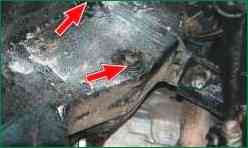
Sharply turning the steering wheel in both directions (this should be done by an assistant), check visually and aurally the fastening of the pendulum lever and the steering mechanism (movements on the fastening bolts and knocks are not allowed)
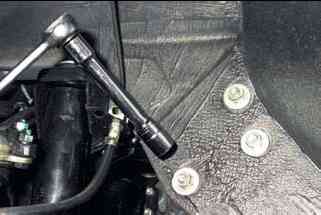
If the steering gear housing and swing arm move from side to side, it is necessary to tighten their fastening to the frame.
Be sure to replace a tie rod end with a damaged joint boot or increased clearance in the joint with a new one.
When replacing the tie rod ends, the toe angles of the wheels may be violated.
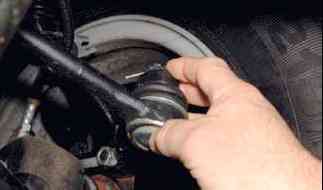
Check the end play in the tie rod ends

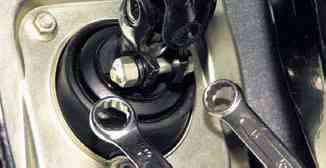
Check the tightness and locking of the ball joint pin nuts.
Under the instrument panel, check the tightness of the pinch bolt nut that secures the steering column intermediate shaft pivot to the steering gear shaft.

Take a close look at the front tires.
Strong impacts from the road surface, especially when hitting potholes, can cause delamination of the cords in the tire carcass and the appearance of a bulge (“hernia”) or misalignment of the tire
A possible cause of vibration and bumps on the steering wheel when driving at speeds above 70-80 km/h may be an imbalance in the front wheels.
Contact a car service or tire shop to check the balance of the front wheels.
If shock and vibration on the steering wheel appear at the moment you press the brake pedal, you need to replace the brake pads, repair or replace the front brake discs









